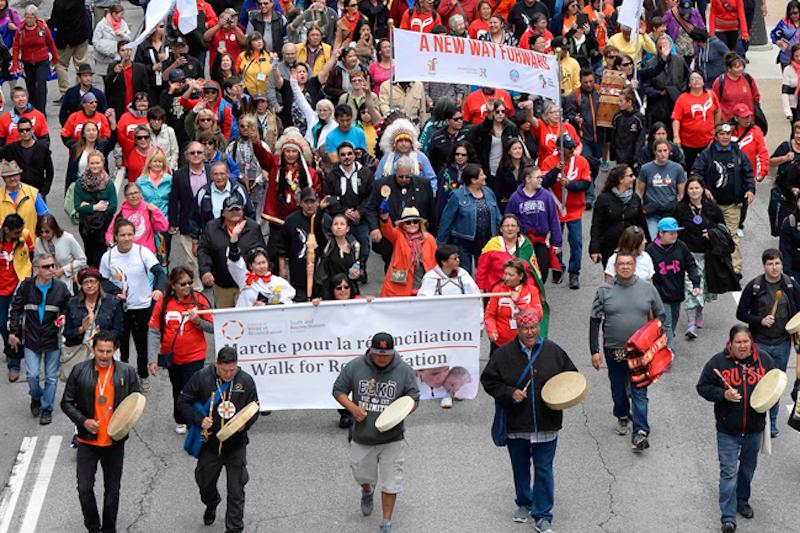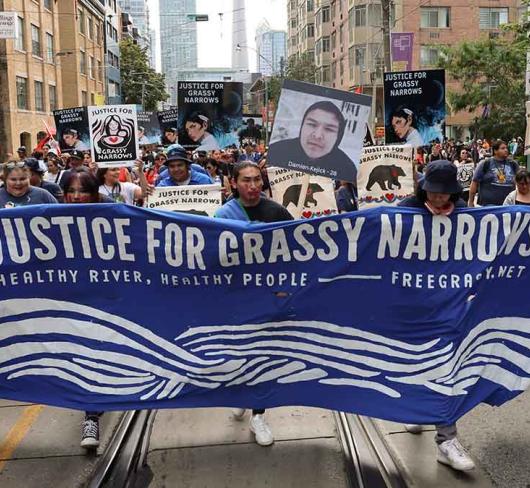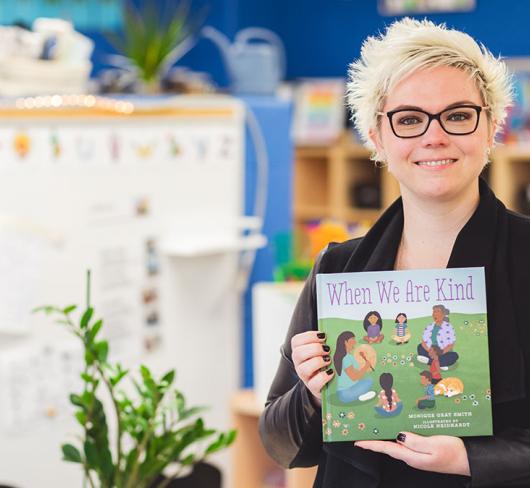
Learning the Truth and Our Journey Into Reconciliation
“When we got to Providence, my brother was scared. We got off the plane. There were nuns waiting for us on the shore, brothers, Father, priests. He, he was so scared, so he grabbed hold of my hand, he was holding my hand… And then top the hill, the priest came, and he told me he’s got to go this way, and, and then the Sister came over to me, told me you got to go this way. They’re trying to break our hands apart, but he wouldn’t let go of my hand, holding. And the priest was holding his hand, and the Sister was holding my hand. They broke our hands apart like that.”
- Florence Horassi, Statement to the Truth and Reconciliation Commission of Canada, Tulita, Northwest Territories, May 10, 2011
On June 1, 2008, just days before the Prime Minister’s public apology to residential school survivors and their families and communities, the Indian Residential Schools Truth and Reconciliation Commission (TRC) was established. The commission was to investigate and research the legacy of the residential school system. In 2009, the government appointed the Honourable Justice Murray Sinclair as Chairperson and Dr. Marie Wilson and Chief Wilton Littlechild as Commissioners of the TRC. They journeyed across Canada to document the experiences of people who attended residential schools and the lasting effects this system had on families and communities. Over the course of seven years, the TRC interviewed hundreds of survivors and their families, developing an historical timeline of residential schools in Canada and compiling information on the operation and policies of the schools. In June 2015, the TRC publically shared the testimonies and 94 recommendations in a final report.
Moving from Apology to Action
“And my mother was on the beach when I was boarding the plane. With few clothes I had, maybe one pair of pants, maybe a sock that my mother had put into her fl our sack. And I know that she started walking home not even bothering to look at me. And today I think maybe she had tears in her eyes. Maybe she was crying.”
- Joe Krimmerdjuar, Statement to the Truth and Reconciliation Commission of Canada, Inuvik, Northwest Territories, June 30, 2011
The residential school system imposed European culture, values, and religious beliefs on First Nations, Métis and Inuit (FNMI) people. For over 150 years, FNMI people in Canada were subjected to the forcible removal of children from their families, communities and traditional ways of life to attend church-run, government-funded, Indian residential schools – all in the name of education. The government based its actions on the assumption that Aboriginal peoples were inferior and needed to be civilized and assimilated into mainstream society. Key Canadian political figures supported the recommendations of the 1879 Davin Report to remove Aboriginal children from their families and place them in residential schools. This was further supported by Sir John A. Macdonald who developed a mandatory residential school policy to separate Aboriginal children from their “savage” parents. In 1883, Macdonald stated that residential schools were necessary in order for children to embrace the “habits and modes of thought of white men.” In 1920, Duncan Campbell Scott, the Deputy Minister of Indian Affairs, shared his support of this policy by stating, “Our objective is to continue until there is not a single Indian in Canada that has not been absorbed into the body politic.”
Aboriginal children were exposed to poor living conditions and many forms of abuse while attending residential schools. Arriving at the schools, children would undergo a harsh cleansing that included having their hair shaved off or cut. Children were separated from their siblings and housed in dormitories that were often cold and drafty. Speaking in their native language or practising any spiritual or cultural practices was forbidden and resulted in harsh discipline. The meals were simple, bland and never enough. In some residential schools disturbing nutritional experiments were conducted on children. Each day would begin with prayer and a few hours of school work, then children did manual labour and chores.
Residential schools were not good places for children. Thousands of survivors have reported sexual abuse, physical violence and emotional traumas they still carry today. Some children attempted to run away from school and go back to their communities. When found, these children were returned and punished. Some children were never found or seen again. Six thousand children died while attending residential schools, their bodies never returned to their families. The odds of an Aboriginal child dying while in the care of the federal government was one in 25. Compare that to the one in 26 odds of Canadians dying during WWII.
Although the residential school system ended in the late 1960s, the last residential school didn’t close its doors until 1996. It is estimated that 150,000 Aboriginal children attended residential schools in Canada and 70,000-80,000 survivors are still alive today. The effects on multiple generations of Aboriginal people have been devastating, touching every aspect of individual and community life.
The residential school system had devastating impacts on survivors, their descendants, communities, languages, cultural practices and traditional knowledge and way of life. Children who attended these schools were not provided parenting skills and were shown very little affection. Speaking a native language and performing any cultural and traditional practices were banned and grounds for punishment. The intergenerational impacts are too many to count.
In addition, Aboriginal peoples live with ongoing negative misconceptions, stereotypes and racist attitudes directed at them. In the face of all this, First Nations, Métis and Inuit people have demonstrated their strength, unity and resilience. “Canada needs to move from apology to action if reconciliation with Aboriginal Peoples is to succeed, the Truth and Reconciliation Commission said in its landmark report… Reconciliation… is not a one-time event, but a ‘multigenerational journey that involves all Canadians’ in schools and beyond.”
Healing and reconciliation needs to happen for all people living in Canada. So where do we go from here?
Recommendations
With the objective of reconciliation and renewed relationships between Aboriginal peoples and Canadians, the TRC completed their journey and produced a fi nal report of their fi ndings in June 2015. Ninety-four recommendations for governments at all levels and for various sectors such as child welfare, health, justice and education are included in this report. The recommendations call for change to policies and programs that historically or currently impact Aboriginal peoples. These calls to action are intended to redress the legacy of the residential schools and move the journey forward into reconciliation for all Canadians and Aboriginal peoples.
Our Journey Into Reconciliation: Preparing Yourself as an Educator
“Reconciliation is not an aboriginal problem – it is a Canadian problem. It involves all of us.”
- Justice Murray Sinclair
There are three steps to consider in your journey of reconciliation: learning, unlearning and taking action. First and foremost, learn about the history and legacy of residential schools and the impacts this system has had on the overall well-being of Aboriginal families, communities and cultures. Talk with others about what you have learned and don’t be afraid to ask questions. This will provide you with context and knowledge you were never taught and equip you with new questions and ideas for moving forward in your journey.
Secondly, examine how and what we learned about Aboriginal peoples. Who was telling the story? How much of this information was accurate and positive? How were we influenced in developing our perceptions of Aboriginal peoples? Very few Canadians were exposed to an accurate portrayal of Aboriginal history in Canada and negative perceptions and myths grew from this. Talk about what you learned and don’t be afraid to question this information. This is the unlearning phase and it will take critical thinking and an openness to challenging the socially conditioned misconceptions imposed on all of us.
Finally, continue to take action. As educators, we can create positive change in our learning environments and the learning of our students by providing culturally relevant and authentic content and presence. Engage in learning opportunities that will empower you and equip you with tools and information that continue your journey in reconciliation. Talk with others about what you’ve learned and what you need in order to create a more holistic and inclusive learning environment. Again, don’t be afraid to ask questions. You have the power to create positive change.
Education plays a key role in reconciliation. As educators and community members on the traditional territories of Indigenous peoples, we have the power to bring about positive change in our classrooms, schools, community and families by initiating changes in our teaching practices and calling for change in the larger systems that impact policies and programs.
A Personal Journey
In January, I had the privilege and honour of representing ETFO at the National Centre for Truth and Reconciliation Education Roundtable at the University of Manitoba. Despite the -30 degree temperature in Winnipeg, it was good to be with people from various teacher federations and ministries of education from across Canada. We came together to discuss best practices and next steps in Aboriginal education. During that week, everything I did at work revolved around truth and reconciliation, from writing an article for Voice, brainstorming and planning a two day webinar for members, to delivering a workshop for the Spirit Horse leads on the TRC.
It was also a time for refl ection. I wore three pieces of beaded jewelry that week to remind me of how important our work in education and reconciliation truly is.
I wore a red and turquoise beaded necklace that was gifted to me when I was in my late teens by my grandmother. I wore this to acknowledge the sorrow she bore when her children were taken away to residential school. As a parent, I can’t imagine the heartache.
I wore a white and blue beaded bracelet that my mother made for me years ago. I wore this to acknowledge the pain she experienced as a youth in her community. My mother has a grade one education and was responsible for looking after her grandparents. When the children left for school, she stayed with her grandparents on the land. Later, when she returned to her community, it was stricken with grief and immense pain. All of the children were gone. Imagine that – a community with no children. She told me, “it was like someone had died in the community – but everyone had lost someone.” The thought of this is unimaginable.
Last year, my great-niece Kaleigh-Jo made me a pair of hooped earrings adorned with turquoise and white beads and a silver feather hanging in the centre. I wore this to acknowledge hope for a future that includes education that appropriately and authentically includes her cultural heritage and our shared history, as this will empower her and bring our communities together.
These three items are gentle reminders for me. They speak to our resilience, strength and perseverance as Indigenous people, as well as to where we’ve been and where we’re going.
I did not see my cultural heritage or worldview represented in my learning environment, and I have had my share of experiences with racism within and beyond the school walls. These impacted me personally and academically. Growing up, I didn’t have a holistic perspective on the issues that were present in Aboriginal communities and families. I just remember thinking that it was crazy that so many people of Aboriginal descent were experiencing similar issues in communities across Canada. Through the eyes of a young adult it just didn’t make sense. Due to the racism I experienced while attending elementary and secondary school, I felt shame about my cultural identity. I internalized negative perceptions and I remember thinking, “Why couldn’t we be just like them?”
Some years after dropping out of high school, I obtained my grade 12 equivalency at a community college. It wouldn’t be until I was enrolled in an “Aboriginal” program at the college that I would learn about our history in Canada – treaties and agreements, the Indian Act, the White Paper, Aboriginal rights, and a few other important pieces of Canadian history that seemed to somehow be absent from the mainstream curriculum. However, it was my introduction to the Indian residential school system that was the real eye-opener. Like many other Aboriginal people in Canada, particularly of the generation that did not have to attend this school system, this was the fi rst time that I would learn about Indian residential schools and their impact on Aboriginal people. It was like I found the missing puzzle pieces to understand my experience. No one in my family ever talked about residential schools. The missing pieces were now in place and I was able to see the whole picture.
Reconciliation can happen in many ways. My journey in reconciliation began years ago. It included looking at the child in me and forgiving her for the shame she felt. She did not know that what she saw happening in Aboriginal communities was part of a much larger picture. This larger picture included colonialism and oppression that aimed to destroy the identity and dignity of Aboriginal people. My journey in reconciliation also includes doing my part in education. The rich diversity and worldviews of Aboriginal peoples and the cultural pedagogy of each group are unique. I acknowledge and honour the strength and perseverance that we share collectively. In education, I continue doing my part to ensure that Aboriginal peoples are appropriately and authentically refl ected in learning environments and the curriculum. I support my ETFO brothers and sisters by providing them with learning opportunities that encourage, inspire and engage them in reconciliation.
My personal journey as an Aboriginal person in education has been challenging and stimulating both emotionally and analytically. It went from having been excluded from the curriculum and dropping out of high school to learning about the history of Canada and understanding the impacts it has had on Aboriginal peoples. And now I am working for the largest teacher union in Canada. I’m grateful for the journey thus far and for the opportunity to refl ect on my own experience and that of my family. I really had to examine my own place in the reconciliation process. It begins with me. Reconciliation begins with each of us.
Rachel Mishenene is an executive staff member at ETFO.

